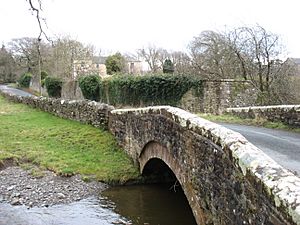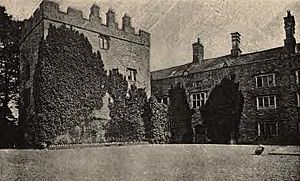Isel Hall facts for kids
Isel Hall is a very old house in Cumbria, England. It sits on a steep hill next to the River Derwent. You can find it about two miles south of Bassenthwaite Lake. The hall offers amazing views of the Lake District mountains and Skiddaw. For many years, it was the home of the Lawson family. Today, it is a special building with a Grade I listing, meaning it's very important historically.
Contents
Exploring Isel Hall's Past
Early Days: Norman Times
The story of Isel Hall began a long time ago, during the rule of King Henry II. Back then, a man named Alan gave some land, including Isel, to Randulph d'Engayne. Later, Randulph's granddaughter, Ada, married Simon de Morville. Their son, Hugh, had two daughters, Ada and Joan. Isel Hall became part of the elder sister Ada's share. She married Richard de Lucy, and then Thomas de Multon. Her son, also named Thomas, later gave Isel to his younger son, Hubert.
The Leigh Family's Time
In 1315, Hubert's grandson, William, had a daughter named Margaret. She married Sir William de Leigh. This marriage brought Isel Hall into the Leigh family. They owned the hall for a long time, from the reign of King Edward II until 1572.
In 1499, a man named Robert Leigh from Isel helped Elizabeth Dykes. She was trying to get justice for her husband, Alexander Dykes, who had been murdered. The judges decided that the people responsible should apologize and pay Elizabeth money. They also had to pay a priest to sing for Alexander's soul in the church at Isel for two years.
Later, in 1509, Sir Edward Redmain owned Isel. He had married Elizabeth, the widow of Sir Thomas Leigh. After Elizabeth died in 1529, Isel went to Sir John Leigh. He was an important person, serving as the High Sheriff of Cumberland twice.
The Lawson Family Era
The Lawson family took over Isel Hall after the Leighs. Their story goes back to the 1200s in Yorkshire. A very important Lawson was Sir Wilfrid Lawson (1545–1632). He was educated at Trinity College, Cambridge. In 1591, the Earl of Northumberland made him a top manager of his estates. Sir Wilfrid was also elected to Parliament for Cumberland several times. He was even knighted in 1604 by the King.
Since Sir Wilfrid had no children, his great-nephew, Sir Wilfrid Lawson, 1st Baronet, of Isell, inherited Isel Hall. This Sir Wilfrid was also a politician. He bought the title of a Baronet in 1688. He also bought another estate called Brayton. He gave Isel to his grandson, who became Sir Wilfrid Lawson, 2nd Baronet, of Isell.
The 2nd Baronet, Sir Wilfrid Lawson (1664–1704), was also a politician. He was the High Sheriff of Cumberland and represented Cockermouth in Parliament. His eldest son, Sir Wilfrid Lawson, 3rd Baronet, of Isell, took over after him.
The 3rd Baronet (1697–1737) was a very smart man. He was a Fellow of the Royal Society, which is a big honor for scientists. He was also a politician, serving King George I. He had two sons, Wilfrid and Mordaunt. Sadly, both sons died when they were very young. This meant the main line of the Isel Lawsons ended.
After 1743, other members of the Lawson family likely lived at Isel. Then, in 1806, the Wybergh family moved in. Later, in 1877, Princess Louise and her husband visited Isel Hall. They were guests of Percy S Wyndham, who was a Member of Parliament.
In 1891, Sir Wilfrid Lawson, 3rd Baronet, of Brayton took over the estate. He lived at Isel until he died in 1937. His nephew, Sir Hilton Lawson, 4th Baronet, then inherited the hall.
Isel Hall Today
After Sir Hilton Lawson passed away, Isel Hall was sold to Margaret Austin-Leigh. She was a distant cousin. Margaret was a fascinating person. She bred Shetland ponies and large Poodle dogs at Isel. She was also related to the famous writer Jane Austen.
Margaret had no children. When she died in 1986, she left Isel Hall to her friend, Mary Burkett. Mary Burkett was a very respected museum director. She had done a lot of work to improve Isel Hall, especially the old Pele Tower and gardens. Mary also wrote a book about a former maid at Isel Hall. Mary Burkett passed away in 2014, and the house is now owned by new people.
The Hall's Location
Isel Hall has a very unusual location on the north side of the River Derwent. Usually, old towers were built on the south side of a river. This way, the river would protect them from enemies coming from the north, like the Scots.
However, in medieval times, there was a thick forest between Isel and Scotland. This forest made it hard for Scottish raiders to get through. The only way they could reach Isel was from the south, either by an old Roman road or by boat up the Derwent valley. So, Isel Hall was actually in the perfect spot for defense! A small stream called the Bloomer Beck also runs around the north and west sides, adding more protection. The name "Bloomer Beck" might mean there was once a metal workshop or iron smelter nearby.
What Isel Hall Looks Like
The Pele Tower
The most amazing part of Isel Hall is its Pele Tower. This tower, along with the Great Hall, is the oldest section of the building. We know that in 1387, Scottish armies attacked nearby Cockermouth Castle. The Pele Tower was probably built soon after this attack to help protect the area.
The tower has a special doorway in its basement called a Carnarvon arch. This type of arch suggests the tower was built in the early 1400s. The tower is rectangular and quite large, about 13 meters tall. Its walls are very thick, about 2 meters! The basement has a curved ceiling, and there are three floors above it. The top floor has windows that look like they were built during the time of King Henry VIII.
The Grand Hall
Another part of the hall, built in the 1500s, stretches out about 38 meters to the west. It has a sloped roof and decorative stone arches on the outside. Many square windows with red sandstone frames let light into this part of the building. Above one doorway, you can see a weathered coat of arms.
The earliest part of this section included a large banqueting hall. This was a big room for feasts and gatherings. It is now divided into the dining room, study, and a passage. The ceiling of this area has beautiful wooden beams. The walls are covered in lovely Tudor wood panels. You can even see the Lawson family's coat of arms carved into the wood.
The Hall's Front (Façade)
The front of Isel Hall is also very unique. The roofline has special decorations that stick up from the top of the wall. There's only one other building in England with similar decorations, and that's Hardwick Hall in Derbyshire. These decorations are open stone arches that rise above the roof.
Sale of Items from Isel Hall
In July 1960, a huge sale took place at Isel Hall. A large tent was set up on the lawn outside the front door. Over three days, 1,071 items from inside the hall were sold! The sale catalog was 30 pages long.
There were many different things for sale. This included metal items, silver, and lots of furniture. There were also carpets, china, glass, paintings, curtains, books, and linen. Imagine how much work the maids had, as there were almost 300 lots of linen! This included 31 tablecloths, 60 linen sheets, and over 200 towels.
People came from all over the country and even from other countries to buy things. But most of the items were bought by local people. The most expensive item was a beautiful mahogany bookcase that sold for £300. Other items included old silver salt cellars, a coffee pot, and a musical snuff box.
Some furniture pieces sold were Chinese Chippendale chairs, a tall longcase clock, and a Regency sideboard. Many beautiful carpets and china sets were also sold.
However, one amazing deal went almost unnoticed. An Italian renaissance painting had been hanging in the dining room for over 200 years. People thought it was just a copy of a famous painting called "The Three Ages of Man." An unnamed buyer paid only £200 for it. But within a year, an American art collector bought the painting. He spent 30 years trying to prove it was an original masterpiece by the Italian painter Giorgione.
|



